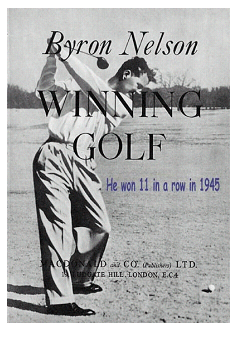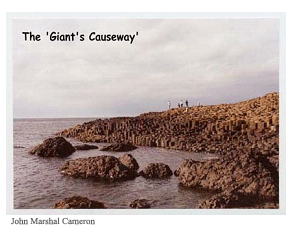|
| |
|
rounds - “possibly the best round I ever
saw”, wrote Longhurst. A ‘humble’ congratulatory telegram arrived
from L.G.Crawley in London, much appreciated by Henry. The following
year I was to see another vintage Cotton performance at closer
quarters. With British players taking the first four places, the much-vaunted Americans had not enjoyed Carnoustie or the Scottish weather and their mood was not improved when Henry Cotton went on to defeat the nominee of the US Ryder Cup team, Denny Shute, 6&5 in a £500 challenge match for the unofficial World Matchplay Championship at Walton Heath. Cotton was 4 under 4’s when the match ended and Bernard Darwin wrote: “Such a score at Walton Heath, stretched to the back of beyond and measuring over 7000 yards, is beyond argument”. He went on: “In every single part of the game he was yesterday as near as might be the ideal golfer and he finally polished off his opponent with an avalanche of long putts….” As a result of this performance the U.S. Press gave Henry their ‘Golfer of the Year’ award.  On
their return home some of the US Ryder Cup team members spoke of
gamesmanship and poor crowd behaviour at Carnoustie and Southport &
Ainsdale, although no complaints had been voiced at the time. Byron Nelson,
ever the gentleman, was not one of them and in 2002 the
ninety-year-old, replying to a letter from the club in connection
with their centenary preparations, said that the match was played
with friendly rivalry and had helped to build his confidence in the
game. Nelson and Ed Dudley had been described as ‘Lambs to the
slaughter’ when drawn to play Henry Cotton and Open Champion, Alf
Padgham. After they defeated the British pair 4&2 the headline was
‘LAMBS BITE BUTCHERS’. One of Nelson’s abiding memories was of the
US teams’ wives huddled outside the men only S&A clubhouse on the
cold and windy final day, until the Lord Mayor’s wife ushered them
inside and warmed them up with ‘old port wine’. In 1945 Byron Nelson
was to set a record that even Tiger will surely never break. He won
eleven consecutive tournaments in America; that year he earned
$52,000, in ‘War Bonds’ and was able to retire to his ranch a couple
of years later at the age of 34. On
their return home some of the US Ryder Cup team members spoke of
gamesmanship and poor crowd behaviour at Carnoustie and Southport &
Ainsdale, although no complaints had been voiced at the time. Byron Nelson,
ever the gentleman, was not one of them and in 2002 the
ninety-year-old, replying to a letter from the club in connection
with their centenary preparations, said that the match was played
with friendly rivalry and had helped to build his confidence in the
game. Nelson and Ed Dudley had been described as ‘Lambs to the
slaughter’ when drawn to play Henry Cotton and Open Champion, Alf
Padgham. After they defeated the British pair 4&2 the headline was
‘LAMBS BITE BUTCHERS’. One of Nelson’s abiding memories was of the
US teams’ wives huddled outside the men only S&A clubhouse on the
cold and windy final day, until the Lord Mayor’s wife ushered them
inside and warmed them up with ‘old port wine’. In 1945 Byron Nelson
was to set a record that even Tiger will surely never break. He won
eleven consecutive tournaments in America; that year he earned
$52,000, in ‘War Bonds’ and was able to retire to his ranch a couple
of years later at the age of 34.There had been rumours circulating that the 1937 Ryder Cup match had not been a financial success and could be the last. Commander R.C.T. Roe, the PGA secretary and team manager since 1935, issued a denial and revealed that a cheque for £2535 was on the way from Southport Corporation and the match receipts had broken all records. There was plenty of money in the PGA coffers to send the team to the USA for the 1939 match which, given the feelings of some Americans, was likely to have been a very keenly contested affair. In the event there was to be a ten-year cooling off period before the teams met again in 1947.  Shortly after I returned from Carnoustie my wife and I headed for
the Irish Open, which we treated as a short holiday break. We were
both very fond of Ireland where we received the most wonderful
hospitality. I must confess to some misgivings after the Carnoustie
experience, but Paddy, always optimistic and supportive, said,
“Maybe this is the one that will turn it around”. ---- Prophetic! Shortly after I returned from Carnoustie my wife and I headed for
the Irish Open, which we treated as a short holiday break. We were
both very fond of Ireland where we received the most wonderful
hospitality. I must confess to some misgivings after the Carnoustie
experience, but Paddy, always optimistic and supportive, said,
“Maybe this is the one that will turn it around”. ---- Prophetic!
The championship that year was at the magnificent Dunluce links at Royal Portrush, near the Giant’s Causeway in Antrim. The links was re-designed by Harry Colt in 1932 and it is said that he looked upon it as his masterpiece. The many curving fairways put a premium on accuracy, with deep rough waiting if you bite too much off the corners. The first Irish Open champion, ‘galloping’ George Duncan, was in the field, now in his mid fifties but playing as quickly as ever. I recall an amusing exchange I had with an Irish amateur known as ‘Bunny’ NEXT |
